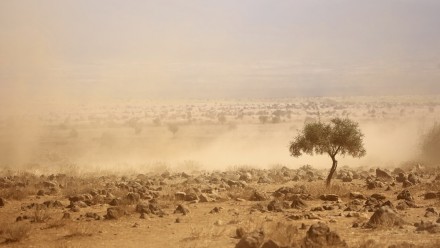How to feed Africa as the climate changes
A team of international scientists has quantified the threat that climate change poses to nine staple food crops in sub-Saharan Africa and outlined actions and timelines needed to adapt to head off the risk of crop and food shortages.
The research, published in Nature Climate Change, examined region-by-region the likely effect of different climate change scenarios on nine crops that constitute 50 per cent of food production in sub-Saharan Africa.
“Without significant and urgent transformation of agricultural practices, food security will become a major issue for millions of people,” said co-author Professor Mark Howden from The Australian National University (ANU) and Director of the ANU Climate Change Institute.
Sub-Saharan Africa is home to 950 million people, with more than 200 million people hungry or undernourished. Almost two thirds of the population depend on agriculture for their livelihoods. These are already being affected negatively by climate changes.
The study found up to 30 per cent of areas growing maize and bananas, and up to 60 per cent of those producing beans could become unviable by the end of the century in moderate to extreme climate change scenarios.
The international team outlined the best way that the risks could be addressed. Some regions will need to change the types of crop grown, while others might need to change the location of cropping.
“In some areas transformations will need to take place as soon as 2025,” said Professor Howden.
“For example, the banana growing regions of West Africa and the maize growing regions of Southern Africa will be particularly hard hit.
“Some solutions such as breeding improved crops can take a minimum of 15 years to complete, so we need to take action now so as to make future adaptation more effective, efficient and equitable,” Professor Howden said.
“This will require a concerted effort on the part of governments and other institutions in creating a supportive policy environment, providing funding for research, development and extension, removing barriers to changing agricultural practices and locations and ensuring the needs of marginalised groups are catered for.”
The research identified specific priorities for each region.
Recommendations include improving irrigation options and agro-climatic advisory services for farmers, breeding crops with increased resistance to climate change, switching to alternative crops with higher tolerance to heat and drought, and exploring alternative livelihood strategies, such as the introduction of livestock.
The research “Timescales of transformational climate change adaptation in sub-Saharan African agriculture” was published in Nature Climate Change.
FOR INTERVIEW:
Professor Mark Howden, ANU Climate Change Institute
T: + 61 2 6125 7266
E: mark.howden@anu.edu.au
For media assistance, contact the ANU Media Hotline on 02 6125 7979.











